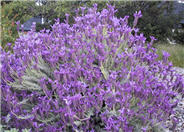
Common name:Tree Aloe
Botanical name:Aloe arborescens
This shrub is large, full of branches, and produces deep orange blooms. The flowers produce a nectar that is attractive to many different birds and the plant is grown all over the world.

Common name:Spanish Lavender
Botanical name:Lavandula stoechas
This dense shrub grows 2-3 ft. tall with blue gray foliage and deep purple flowers that have large showy bracts near the top of the spikes. It is drought tolerant . - Cornflower Farms

Common name:Santa Barbara Daisy, Mexican Daisy
Botanical name:Erigeron karvinskianus
This low mounding perennial, with fine leaves and white to pinkish daisy-like flowers, is an excellent asset to rock gardens. Capable of spreading.

Common name:Mission Cactus, Tree Cactus
Botanical name:Opuntia ficus-indica
More tree like than other opuntias to 15'. Usually have no spines but some glochids can be found. Flowers are yellow to orange in late spring and early summer. Fruit is edible. Full sun. Must have good drainage. Frost sensitive to hard freeze. When they are young, the pads, or mopales of this cactus are used to make a delicious salsa, which is reputed to have beneficial health effects. The major pest and source of the red dye cochineal comes from a scale. Escapes cultivation.

Common name:Purple Hopseed Bush or Hop Bush
Botanical name:Dodonaea viscosa 'Purpurea'
This fast-growing shrub has an upright, branching habit that reaches a height of 12-15', with willow-like leaves that are 4" in length. Its foliage is bronzy-green in color, which turns a reddish-purple shade in the fall and winter. It has compact growth and requires full sun for the best results.

Common name:Japanese Blood Grass
Botanical name:Imperata cylindrica 'Rubra'
This ground cover/grass can reach up to 3' tall and has green leaves that are reddish/maroon at the tips. High water needs, best used along riparian or pond areas, in wet soils, or on properties with high water tables.
| Designer: | Lavender and Friends in the Strip |
Photographer: GardenSoft |
Soils and Compost:
Practice grass-cycling by leaving short grass clippings on lawns after mowing, so that nutrients and organic matter are returned to the soil.
Water Saving Tip:
Water trees and shrubs by deep-soaking occasionally with low-volume irrigation equipment (drip, micro-sprays, or bubblers) to promote healthy, deep rooting.
Integrated Pest Management:
Develop healthy soil for plants that are vigorous and naturally pest-resistant.

